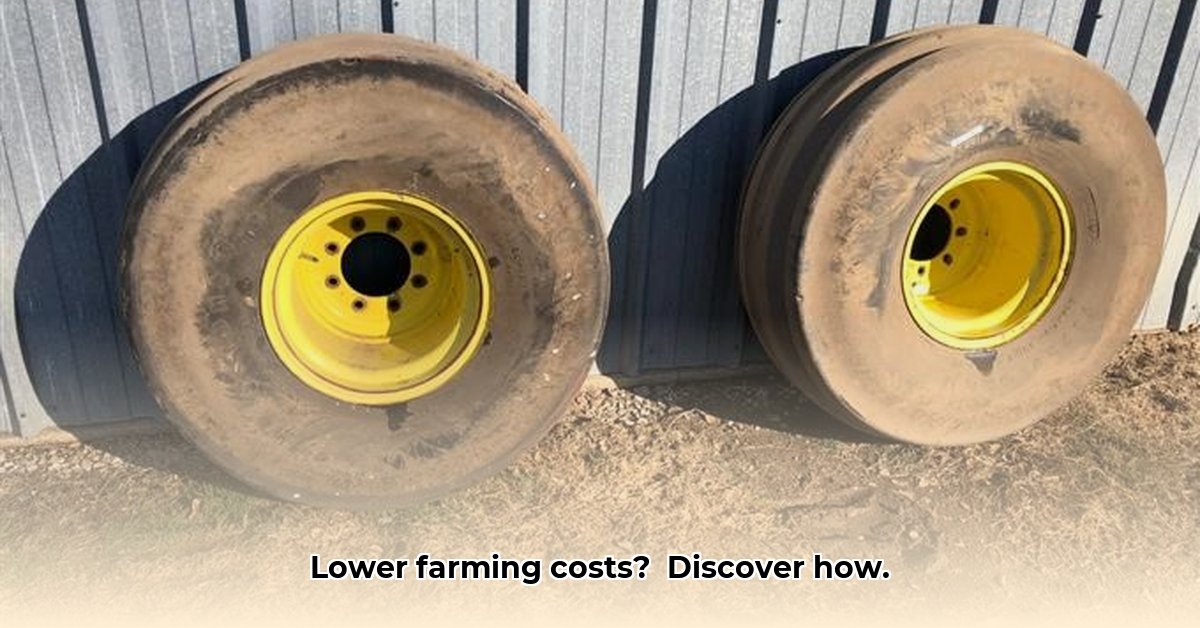
Maximize your farm's efficiency and minimize environmental impact with smart tractor tire choices. This guide focuses on 16.5-16.1 tires, detailing selection, usage, maintenance, and their contribution to sustainable agricultural practices. Learn how informed tire management translates to lower costs, healthier soil, and a more sustainable operation.
Understanding 16.5-16.1 Tractor Tire Specifications
The numbers "16.5-16.1" represent key dimensions: 16.5 inches is the rim diameter, and 16.1 inches is the tire's nominal width. Understanding these dimensions is crucial for optimizing performance and sustainability. These dimensions directly affect the tire's contact area with the soil, impacting traction, soil compaction, and fuel efficiency.
Key Tire Characteristics and Their Impact
Several characteristics significantly influence your farming operation:
Load Capacity (Maximum Weight): Exceeding the load capacity leads to premature wear, increased soil compaction, and potential tire failure. Consult your tractor's manual for the correct load capacity.
Pressure Range (Optimal Inflation): Maintaining the correct tire pressure is vital. Under-inflation increases soil compaction, while over-inflation causes uneven wear and reduces ride comfort. Always refer to your tractor's manual and tire sidewall for the recommended pressure range. Regular pressure checks with a reliable gauge are essential.
Tread Pattern (Surface Texture): The tread pattern impacts traction and fuel efficiency. Aggressive patterns offer superior grip in muddy conditions, but may increase rolling resistance. Smoother patterns improve fuel efficiency on hard surfaces but might compromise traction on softer ground.
| Tire Characteristic | Impact on Fuel Efficiency | Impact on Soil Compaction | Impact on Traction |
|---|---|---|---|
| Higher Load Capacity | Slightly Reduced | Increased | Improved |
| Correct Tire Pressure | Improved | Minimized | Optimized |
| Incorrect Tire Pressure | Reduced | Increased | Reduced (potential slippage) |
| Aggressive Tread Pattern | Reduced | Slightly Increased | Significantly Improved |
| Smooth Tread Pattern | Improved | Reduced | Reduced (on soft ground) |
Don't underestimate the importance of proper tire pressure! Isn't consistent inflation key to maximizing fuel efficiency and minimizing soil compaction?
Tire Selection for Different Agricultural Tasks
Different farming tasks demand specific tire characteristics. Matching the tire type and pressure to the task optimizes efficiency and minimizes soil damage.
1. Plowing: Deep, aggressive tread patterns are crucial for maximum traction. Slightly lower pressure (within the safe range) can enhance grip, but avoid excessive deflation.
2. Planting: A balanced approach is ideal—moderate tread depth and inflation pressure minimize compaction while ensuring sufficient traction for effective planting.
3. Harvesting: Wider tires with a smoother tread pattern are beneficial for transporting heavy loads, reducing soil compaction, and minimizing damage to crops. Maintaining proper inflation is vital for optimal performance.
4. Transport (Road Use): For road travel, prioritize smoother tread patterns to maximize fuel efficiency and minimize wear. Higher pressures (within the safe range) are generally suitable here.
Tire Maintenance: Extending Tire Life and Sustainability
Regular maintenance is crucial for maximizing tire lifespan and minimizing environmental impact.
1. Regular Inspections (Monthly): Carefully examine tires for cuts, punctures, embedded debris, or uneven wear. Addressing issues promptly minimizes the risk of severe damage and premature replacement.
2. Inflation (Weekly): Maintain proper inflation pressure, using a reliable gauge. Consistent pressure prevents uneven wear, improves fuel economy, and reduces soil compaction.
3. Rotation (Every 6 Months or 250 Hours): Regularly rotate your tires to ensure even wear distribution. Consult your tractor's manual for recommended rotation procedures.
Sustainable Tire Considerations: Environmental Impact and Responsible Practices
Sustainable agriculture demands responsible tire management throughout their lifecycle:
Responsible Disposal: Do not discard old tires improperly. Recycle them at designated facilities or through manufacturer take-back programs. Improper disposal harms the environment.
Extending Tire Lifespan: Proper maintenance significantly extends tire life, reducing the environmental impact of frequent replacements.
Sustainable Materials: Research and development of bio-based and sustainable tire materials are ongoing. Investigate these options for future replacements.
Cost-Benefit Analysis: Balancing Initial Investment with Long-Term Savings
While high-quality tires have a higher initial cost, the long-term benefits often outweigh the initial investment. These include:
Improved Fuel Efficiency: Reduced rolling resistance leads to significant fuel cost savings over the tire's lifetime.
Reduced Soil Compaction: Minimized compaction means healthier soil, potentially leading to improved crop yields.
Extended Tire Lifespan: Proper maintenance and correct selection significantly extend tire life, reducing replacement costs.
Conclusion: Investing in a Sustainable Future
Choosing the right 16.5-16.1 tractor tires is an investment in your farm’s long-term health and sustainability. By understanding tire specifications, considering their impact on soil health, and practicing diligent maintenance, you directly influence your farm's profitability and environmental responsibility. Remember to consult your tractor's manual and stay informed about advancements in sustainable tire technology.